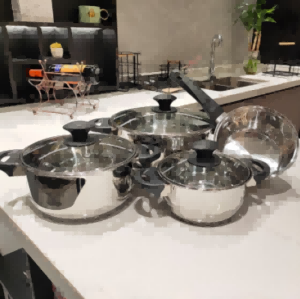
In today's world where the environment is a priority, commercial kitchens strive to be energy efficient in their operations. Investing in modern cookware that has been designed with energy saving attributes can significantly reduce the amount of energy consumed hence lowering utility bills and contribute to carbon footprint reduction. This article highlights how modern cookware can help achieve these goals, making it an essential requirement for every business kitchen.
Advanced Heat Conductivity
Advanced heat conductivity is among the ways through which modern cookware makes cooking more efficient. High end cookers have copper or aluminium cores within stainless steel layers. These multi-ply constructions make sure that they distribute heat fast and uniformly across the pot thereby reducing cooking period as well as amount of energy used during this process. For instance, a pan that heats up quickly and maintains a consistent temperature will use less energy than one that takes longer to reach the desired heat.

Induction Compatibility
Induction cooking is synonymous with high levels of efficiency; therefore, induction compatible pots give users maximum advantage from such functionalities if adopted at home level. With magnetic bases that allow for direct transfer of heat from stove top into pans induction-ready cookware heats up much faster thus preserving some “juice”. It also ensures almost 100% utilization of all generated power unlike traditional gas or electric stovetops which lose substantial amounts of heat to their surroundings.
Improved Insulation and Heat Retention
Contemporary cooking utensils are characterized by better insulation and retention properties when compared to conventional ones. Pans lids close fit on them ensure retention of moisture as well warmth leading to faster meal preparation. It means food does not require one to simmer them for long hours using high temperatures so as to save on power used while still maintaining constant warmth inside(stovewhilestillmaintainingitsconsistenttemperature). It also means that you can switch off the stove earlier since modern cookware has thicker bottoms and walls, which leads to better heat retention without affecting the cooking process.
Non-Stick Surfaces
High quality non-stick pans can be used at reduced temperatures and hence are energy efficient. The coated surfaces prevent food from sticking on them making it unnecessary to add any oils or fats. In addition to this, it is simpler and quicker to clean such surfaces than it would be for regular ones therefore saving water as well as energy that could have been consumed during long hours of soaking and scrubbing.
Precision Cooking Tools
New generation cookware often contains thermal sensors, smart technology and other precision cooking tools. With these features in place, chefs are able to be very accurate with their temperature control leading to reduction in power wastage. Smart pots can connect with mobile apps thus providing real-time information and alerts for optimizing cooking efficiency.
Durability and Longevity
Investment in sturdy high-quality saucepans makes them last longer; hence reducing the number of renewing thus minimizing energy consumption rates over an extended period. Modern kitchen utensils made from materials like stainless steel or cast iron are ideal for commercial kitchens because they can withstand heavy-duty use. This ensures that less resources are required during production, transportation, or disposal of cook ware.
Eco-Friendly Materials
Modern brands of kitchen equipment are increasingly being produced using eco-friendly ingredients alongside processes. Instead of focusing only on environmental issues, companies now consider recycling as well as non toxic coatings so that end products become sustainable too. Such options reduce a restaurant’s carbon footprint hence contributing towards its overall sustainability goals.
The energy-saving features of newly designed cooking utensils can significantly reduce the commercial kitchen’s energy use. Other contributing factors include advanced heat conductivity, induction cook tops, improved insulation capabilities, non-sticky surfaces, precision cookers and other sustainable cooking equipment. A less costly utility expenses can be enjoyed as a result of purchasing high quality energy efficient cooking utensil by using restaurants whereby carbon footprint is reduced and environmental friendliness is achieved. This adoption of contemporary techniques paves path for culinary industry to lead in a greener future.